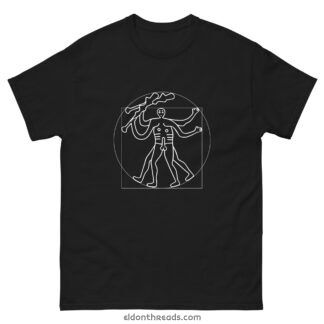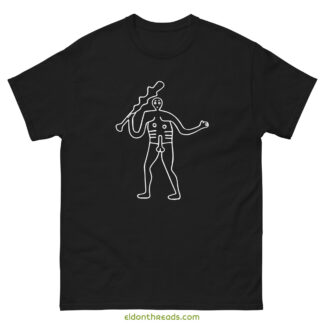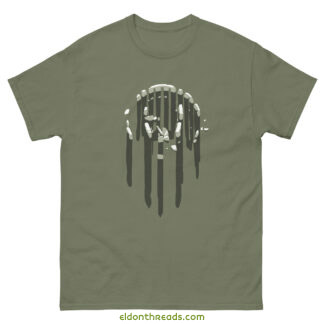Description
This t-shirt shows a version of the original design of the Westbury Horse – based on the illustration by William Plenderleath (White Horses of the West of England).
Plenderleath seems to have based his version on a drawing by Richard Gough which appeared in Camden’s Britannia (1772 edition). However, it has since been discovered that the printing of that illustration had been reversed in error, so you will most often see this horse incorrectly facing right. Eldon Threads are pleased to have restored the Horse to its original left-facing glory!
The Westbury White Horse, located in Wiltshire, England, is not only the oldest of the Wiltshire white horses but also one shrouded in mystery when it comes to its origins. While many theories have been proposed, the exact reason for its creation remains unclear.
One popular belief suggests that the Westbury White Horse commemorates King Alfred the Great’s victory at the Battle of Ethandun in 878. This theory is plausible considering the horse’s proximity to the supposed battle site. However, there is no evidence of this legend before the 18th century, casting some doubt on its authenticity. Nonetheless, King Alfred’s legacy and strong following in England from the 17th century onward may have contributed to the association of the white horse with his triumph.
Historians have speculated that the Battle of Ethandun took place on the high ground near the white horse, providing a strategic defensive position for King Alfred and the Saxons of Wessex. It is believed that Alfred and his forces marched northeast from Egbert’s Stone, while the Danes, led by Guthram, advanced southwest from their stronghold in Chippenham. The white horse’s location is thought to have played a role in this significant historical event, possibly connected to the nearby Bratton Castle, an Iron Age hillfort. However, the precise involvement of the fort in the battle remains uncertain, with some suggesting that the Anglo-Saxon settlement of Chippenham, occupied by Guthram’s Danes, may have been the actual fortress mentioned in medieval texts.
Local folklore surrounding the white horse recounts the story of the defeated Danes fleeing down the slopes to the springs between the villages of Bratton and Edington, where the battle derived its name. According to legend, the pursuing Saxons massacred many exhausted Danes in the woods and boggy ground near the white horse. The surviving Danes fled northeast, relentlessly pursued by Alfred’s men all the way to Chippenham. While this account has been passed down through generations, its historical accuracy remains contested due to limited evidence.
The current depiction of the Westbury White Horse is believed to have been cut in 1778 by a man named Mr. Gee. He overlaid the older chalk figure with the new one we see today. Throughout the 19th and early 20th centuries, the figure underwent periodic reshaping and repairs to maintain its appearance.
The Uffington White Horse, located in Oxfordshire, played a role in King Alfred’s early life. Born in the Vale of White Horse, near Uffington, Alfred had a connection to this ancient chalk figure. Unlike the uncertain origins of the Westbury White Horse, documents from as early as the 11th century refer to the “White Horse Hill” at Uffington. Archaeological research has dated the Uffington White Horse to the Bronze Age, although its original purpose remains uncertain.
The white horse symbol has deep historical roots among the Saxons. It was associated with the continental Saxons in the Dark Ages and is connected to the legendary figures of Hengest and Horsa, who are said to have fought under a white horse standard during the first Anglo-Saxon invasions of England.
During the 18th century, the white horse became a heraldic symbol associated with the House of Hanover, the new British Royal Family. It is speculated by some scholars that the Westbury White Horse may have been carved during this era as a symbol of loyalty to the reigning Protestant house.
Adding to the intrigue, Wiltshire folklore tells a tale of the white horse descending to Bridewell Springs when the nearby Bratton church clock strikes midnight. This local tradition adds an element of mysticism to the Westbury White Horse.

Classic 100% cotton tee with taped neck and shoulders, and a double seam at the sleeves and bottom hem. Eldon Threads logo printed discreetly on the reverse as an outer label just below the neck. Open-end yarn. Tubular fabric. Fabric weight: 5.0–5.3 oz/yd² (170-180 g/m²).
Unveil the secrets of the ages with ELDON THREADS…







